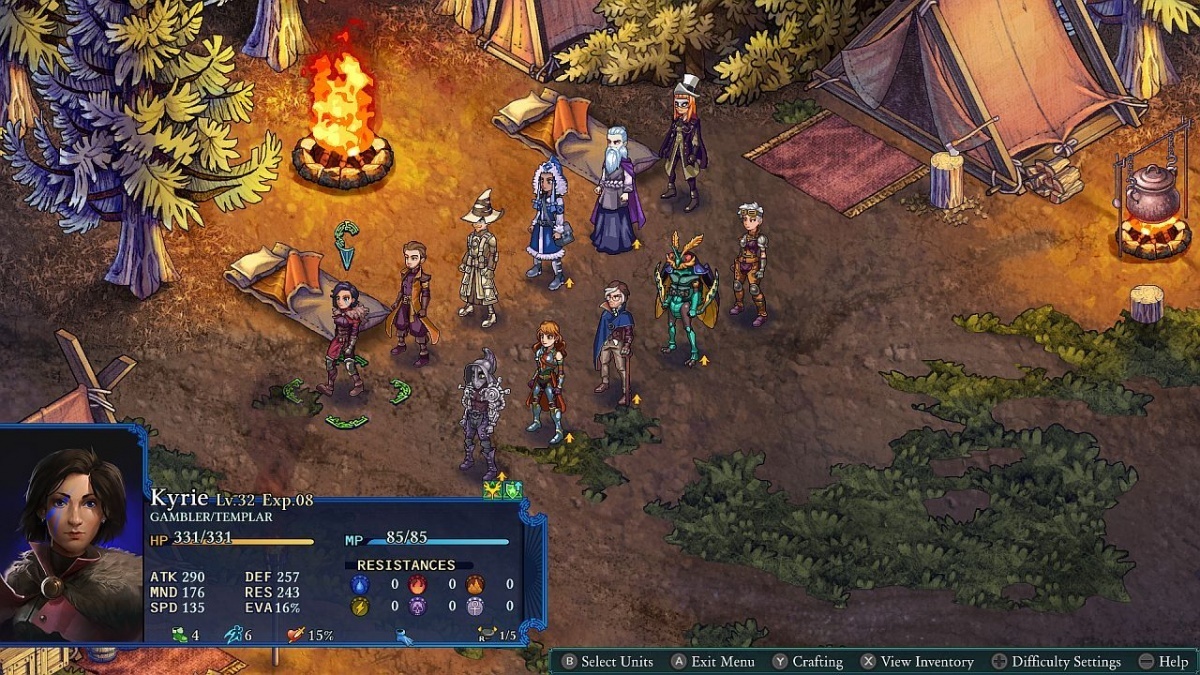Fell Seal: Arbiter’s Mark (Nintendo Switch) Review
By Renan Fontes  29.01.2020
29.01.2020

Whether they're called strategy RPGs or tactical, there's no denying that the genre is as healthy as ever. With Fire Emblem: Three Houses releasing to near universal acclaim, expect to see more developers dipping their toes into the TRPG genre in the near future. At the same time, the modern tactical RPG is very different from what fans may have been used to in the late '90s and early '00s. The same foundations are still present, but there's been less of an emphasis on map design and a push for more traditional RPG elements these past two generations. While it certainly wears its RPG qualities with pride, Fell Seal: Arbiter's Mark is a conscious step back for a genre increasingly becoming more modern.
The first thing most will notice when booting this up for the first time is just how jarring the art style is. Character portraits opt for a more grounded style, while character models look like they're ripped out of a low quality Korean MMO. It's especially off-putting considering how vibrant the background art can be. There's no rhyme or reason to the visual style, which admittedly isn't a great first impression.
Thankfully, Fell Seal wastes no time getting to the meat of things. While story-driven, 6 Eyes Studio's approach to narrative progression is brisker than its contemporaries. In fact, an argument could be made that cut-scenes often move a bit too fast, often struggling to let beats breathe. The story itself isn't particularly interesting in its own right, but the script is well written enough where just going along for the ride is perfectly enjoyable.
It should be noted that the title wears its inspirations on its sleeve, for better or worse. Final Fantasy Tactics clearly had an influence on development, with several concepts being lifted from the TRPG classic. Given that just about every borrowed mechanic is re-contextualized in some capacity, this isn't that big a deal, but it's hard not to draw unfavourable comparisons at times - especially in regards to a story that's more often than not just passable.

Justice as a theme is explored interestingly enough, but the political backdrop inherent within the story doesn't develop as meaningfully as it could. The main characters, while charming enough, also lack the benefit of weighty character arcs, their presence more in benefit of moving the plot along than being influenced by the plot. All the same, it's for the best that the story doesn't get too deep into the politics, as drawing too much direct comparison to Final Fantasy Tactics isn't doing anyone any favours.
Indies that put too much stock into homage tend to suffer, but this isn't all that damning an example. There's more than enough gameplay depth to make up for any narrative shortcomings, and what allusions there are to FFT are tactful. Right out the gate, players can fully customize the difficulty, from how many enemies they fight per battle, to the gear enemies wear. Just about every facet of the curve can be played with to make the experience easier or harder. There are even preset difficulties for those who don't care to individually craft their own level of challenge.
One could assume that so many difficulty options would make the art of balancing trickier, but enemies seemed well-adjusted with this in mind. There's an inherent level-scaling system in place that can be manipulated, but its presence ensures enemies will always pose some semblance of a threat. As is the case with most level-scaling, however, developers need to keep in mind that simply increasing raw numbers doesn't make an experience fun.

Fortunately, enemies behave strategically and logically. They use support skills, they buff and debuff. Audiences who treat TRPGs as entry level RPGs and rarely do anything but attack will suffer fast, but genre veterans are in for a treat: a game where enemies fight back intelligently. This naturally makes for a harder play-through regardless of difficulty options, but it also guarantees that enemy encounters never boil down to just stats. Whether in favour of the player or otherwise.
The gameplay itself is perhaps what most would expect out of the genre. Speed dictates who moves when, with no player/enemy turn distinctions; characters can face in four cardinal directions, affecting damage dealt and received; and, finally, verticality keeps map traversal dynamic. Stages are appropriately grid based, and certain skills spill into other grids, requiring players choose how to attack carefully. Anyone who's played a TRPG before will know what they're getting into.
Fell Seal: Arbiter's Mark is very traditional in this regard, but the overall design is bolstered by an incredible amount of customization. Beyond difficulty options, just about every single aspect of a player's party can be customized. The Injury system, a means of implementing some aspect of permanent consequence, without the extremity of perma-death (though the option is available), keeps players from sticking to the same party. Characters that fall in battle end up worse for wear, necessitating rest.

This naturally results in a party that's constantly changing, and considering how many options there are available, no two players will go through the campaign the exact same way. Beyond just party composition, every single party member can be customized. Non-story relevant party members can even be visually edited, from their skin colour to their hair.
For everyone else, class changes will be their biggest point of customization. Each class has its own level tree that can be progressed through the use of AP (ability points), eventually resulting in characters highly personalized to one's own play style. Enemy encounters are designed with the idea that players will be making the most of everything they have at their disposal, so anyone slacking off in regards to customizing their party will find themselves struggling sooner rather than later.
Fruits of customization's labours make themselves quite apparent as the campaign marches on. As enemies become more aggressive with their buffing and debuffing, while maps keep players at a conscious disadvantage, Arbiter's Mark rewards well composed parties with the greatest award of all: progress. Even toggled to their easiest notches, this is still a TRPG that forces audiences to put some thought into their gaming. It's possible to lighten the load, but there's no free ride to the credits. Which is how it should be, honestly. Regardless of how one chooses to approach the title, Fell Seal: Arbiter's Mark is one of the most enticing TRPGs this generation.

Cubed3 Rating
Great - Silver Award

In spite of a somewhat spotty presentation, Fell Seal: Arbiter's Mark manages to fill a tactical RPG niche that had been lying dormant for far too long. Beyond just serving as a competent TRPG, however, Fell Seal engages with the genre in increasingly dynamic ways. It borrows a good deal of its concepts from Final Fantasy Tactics, but nothing is just brought over as is. While there are conceptual similarities between the titles, this has more than enough mechanical depth to stand on its own. Strong map design and plenty of customization options make this game a must-have for fans of tactical RPGs.

![]() 8/10
8/10
![]() 0
(0 Votes)
0
(0 Votes)
 Out now
Out now  Out now
Out now  Out now
Out now  Out now
Out now Comments
Comments are currently disabled

 Sign In
Sign In Game Details
Game Details Subscribe to this topic
Subscribe to this topic Features
Features





 Top
Top

